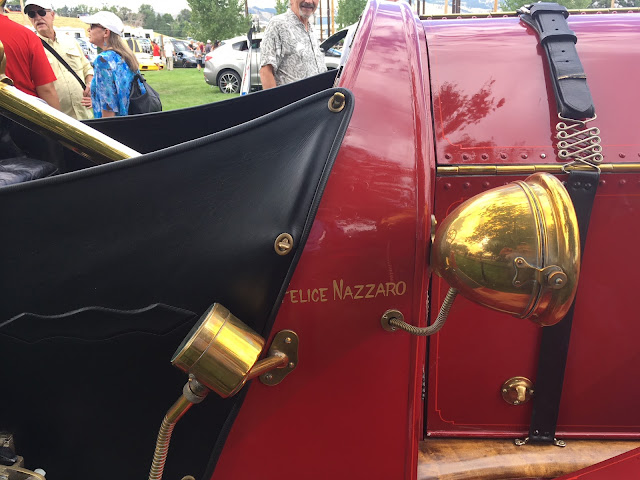Automezzi Colorado is an annual show of Italian machinery (cars and motorcycles) and this was its first year at a new location, the Jefferson County Fairgrounds in the town of Golden. When I arrived late in the morning, there were already crowds around most of the vehicles, and while I waited to photograph this car or that, there was time to notice which cars and motorcycles were attracting the most attention, and from whom...
What struck me first was that despite the presence of lots of new and almost-new cars, visitors clustered around cars that, guessing by their apparent ages, they might have remembered when they were growing up. Or in the case of Ferraris and Maseratis, cars they at least remembered seeing in movies or in the pages of Road & Track from that time in their lives. Now this is not an original thought; it's widely known that car collectors, for example, often seek out examples of cars they wanted (but couldn't afford) when they were in high school.
The one exception to the clustering rule was this astonishing 1913 Fiat Type 55, still capable of exceeding 70 mph in the hands of any soul brave enough to try. Obviously, none of those present would remember this cantankerous old charmer from its reckless youth, or their own, and it attracted old and young in equal measure. Most of the crowd likely associated the Fiat name with the current 500 runabout or the long-running 124 spider which was available here from the the late 1960s through the early 1980s… in other words, with cute little (usually red) cars. And when viewed from a vantage point across the field, the Type 55 seemed to fit into that mold. It was only when you moved in for a closer look that the size of the thing shocked you. With its 9 liter (over 540 cubic inches), four-cylinder long-stroke engine developing all of 60 horsepower, mechanical brakes on rear wheels only, the steering wheel aimed like a lance at the chest of the driver (in this case, the legendary Felice Nazzaro) perched out in the breeze, the Fiat Type 55 gives a new perspective on the phrase "risk-taking" for a generation accustomed to anti-lock disc brakes, air bags and at the very least (from way back, for nearly everybody) seat belts. It's a reminder of a lost generation that would test its courage in other ways the year after this car was built, in the trenches of the Western Front…
It's also a reminder that Fiat built expensive cars long before the mass market ones, and that Fiat had an American assembly plant around a century before Fiat Chrysler, and before any other European firm. Fiat had gained a kind of fame by winning twice and setting speed records at New York's Vanderbilt Cup Race in 1905 and '06, so the company decided to establish a U.S. plant. They'd be followed soon enough by Rolls Royce, and decades later by BMW and Mercedes. Fiat built hundreds of cars, including the Type 55, at a factory in Poughkeepsie, New York, starting in 1910 and ending production in 1918, when the Duesenberg brothers, Fred and August, bought the tooling. They needed it to manufacture Bugatti aero engines under license, as these were still needed for the Great War. And so our impressions of this car circle back to images of flimsy looking, fabric-bodied airplanes, and steam locomotives carrying troops off to that war…
And finally, to a kind of paradox. Perhaps we can only see things truly when they are too far behind us to be subject to our memories, with their clouds of sentiment, romance and plain old inaccuracy. Because we have no recollections of this machine, we can marvel at it and eventually see it, in the way we see those antique biplanes, hydrogen-filled dirigibles, and vast ocean liners trusting their brittle iron hulls in contests with icebergs. We look at the ideas we tried, and the risks we took, in the early days of the Machine Age, and we wonder at the craziness of it all. Perhaps in the same way, future generations will look back at us in a hundred years and see the crazy risks we are taking now.
Photo credit: All photos by the author.
And finally, to a kind of paradox. Perhaps we can only see things truly when they are too far behind us to be subject to our memories, with their clouds of sentiment, romance and plain old inaccuracy. Because we have no recollections of this machine, we can marvel at it and eventually see it, in the way we see those antique biplanes, hydrogen-filled dirigibles, and vast ocean liners trusting their brittle iron hulls in contests with icebergs. We look at the ideas we tried, and the risks we took, in the early days of the Machine Age, and we wonder at the craziness of it all. Perhaps in the same way, future generations will look back at us in a hundred years and see the crazy risks we are taking now.
Photo credit: All photos by the author.



No comments:
Post a Comment